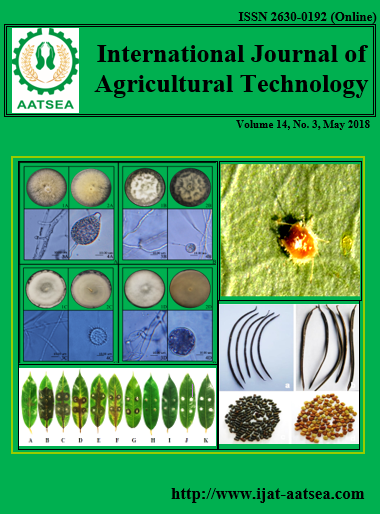Effect of Plant Extracts, Bio-insecticides, Petroleum Oil and Insecticides for Controlling Rose beetle (Adoretus compressus, Coleoptera: Scarabaeidae: Rutelinae) in Immature Oil Palm
Main Article Content
Abstract
The adult of rose beetles feed on the leaves of oil palm (Elaeis guineensis jacq.) that cause to be decreasing of growth rate. The outbreak of these beetles is usually found in new planting area. It is necessary for farmers to use insecticides for controlling. The effect of pesticides to control rose beetle in 2-year-old oil palm plantation was conducted in Thungsong district, Nakhon Si Thammarat province, Thailand from July, 2015 to January, 2016. Result showed that the effectiveness of treatment after the last spraying was carbaryl 85% WP followed by carbosulfan 20% EC, petroleum oil 83.9% EC, bactospeine FC, tobacco 3%, Thai neem extract (azadirachtin 0.05%), which were 85.93 80.71 79.97 63.86 60.00 and 56.37%, respectively, compared with non-treated control. The integrated pest management (IPM) program to control rose beetle was resulted after treated with M1 (tobacco 3%), M2 (petroleum oil 83.9% EC 40 ml/20 L.of water), M3 (carbaryl 85% WP 60 g./20L.of water, M4 (tobacco 3% (3%)+ carbosulfan 5% G 200 g./tree), M5 (petroleum oil 83.9% EC 40 ml/20L. of water+carbosulfan 5% G 200 g./tree), M6 (carbaryl 85% WP 60 g./20L. of water+carbosulfan 5% G 200 g./tree), M7 (carbosulfan 5% G 200 g./tree and M8 (non-treated control). The highest effectiveness methods were M6 (100%), followed by M3, M7, M4, M5, M2 and M1 which were affected to control as at 86.62 74.98 73.86 70.59 66.54 and 62.82 %, respectively, which compared to M8.
Article Details

This work is licensed under a Creative Commons Attribution-NonCommercial-NoDerivatives 4.0 International License.
References
Agricultural office (2016). Newsletters, Knowledge Management of Rose Beetle. Agricultural Extension Office, Office of Plant Genetic Conservation. Pest and Disease Prevention Division, Department of Agriculture. Surat Thani.
DOA (2011). Insect pests, vegetables, mushrooms and flowering plants. The Research Institute for Plant rotection Research. Department of Agriculture. Bangkok.
DOA (2016). Oil palm 1. Department of Agriculture. Bangkok. Retrieved from http://www.doa.go.th/palmsurat/images/e-book/compressed. pdf
Handerson, C. F. and Tilton, E. W. (1995). Tests with acaricides against the brown wheat mite. Journal of Economic Entomology 48:157-161.
Mcquate, G. T. and Jameson, M. L. (2011). Distinguishing male and female Chinese rose beetles, Adoretus sinicus, with an overview of adoretus species of biosecurity concern. Journal of Hawaiian and Pacific Agriculture 5:37-42.
Muniappan, R. (2012). Arthropod Pests of Horticultural Crops in Tropical Asia. Boston, USA: CABI Publishing.
Oil Palm research center (2016). Oil Palm. Pest and Disease Prevention Division. Department of Agriculture. Bangkok.
Pena, J. E., Sharp, J. L., and Wysoki, M. (2002). Tropical Fruit Pests and Pollinators: Biology, Economic Importance, Natural Enemies and Control. CABI, Wallingford, pp. 361-390.
Sahaya, S. (2017). Forcasting of Rose Beetle Outbreak. Department of Agriculture. Retrieved from https://m.facebook.com/PATRS.DOA/videos/919681748171740/
Spafford, H., Ching, A., Manley, M., Hardin, C. and Bittenbender, H. (2016). Management of Chinese Rose Beetle (Adoretus sinicus) Adults Feeding on Cacao (Theobroma cacao) Using Insecticides. Journal of Economic Entomology 7:28. doi: 10.3390/insects7020028.
Sintusatepalmoil (2017). Pest Management of Oil Palm. Retrieved from https://www.sintusatepalmoil.com/index.php?lay=show&ac=article&Id=539259317&Ntype=2.


